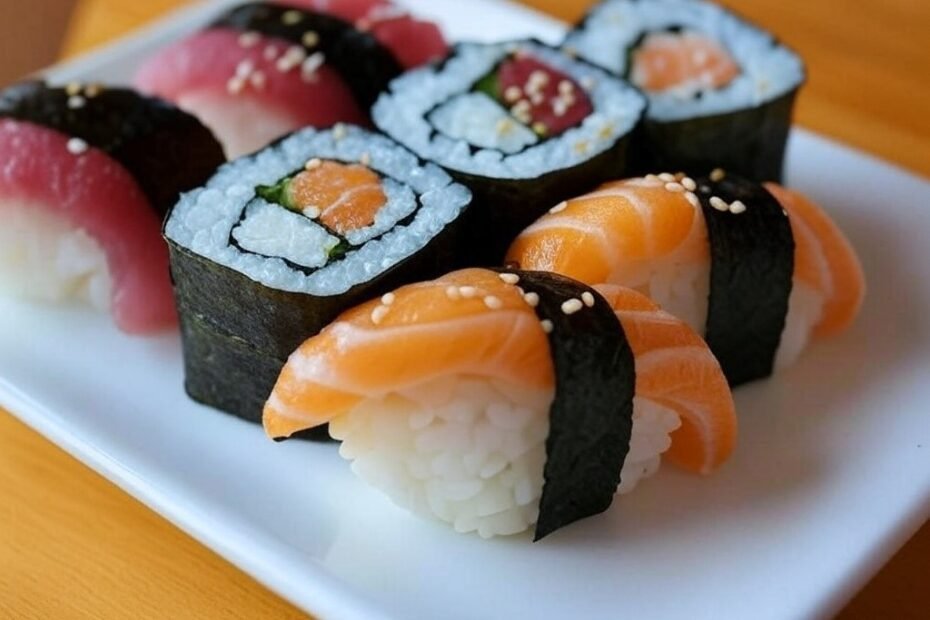By Gary Baker ( A young apprentic Chef ) Guest Post
When I first stepped off the Shinkansen into the soft snow of Sendai five months ago, I was twenty-five, underprepared, and completely unaware of what would come to define my relationship with food.
I’d trained at a small culinary school in York, cooked in a few pubs and modern kitchens, and was always told I had a “clean hand” with fish. But none of that prepared me for the reality of apprenticing in a sixth-generation sushi-ya (寿司屋) tucked behind a lantern-lit alley near the Hirose River.
Here in Sendai, in the quiet rhythm of northern Japan, I found something I never expected: humility on a plate. Specifically, in Nigiri Sushi—the simplest, most disciplined expression of fish and rice you can imagine.
The Apprenticeship: Humility Before the Knife
The restaurant is called Sushi Aoyama, and it’s run by the Aoyama family—father, mother, son, and one deeply skeptical grandmother who watches every movement from a lacquered stool in the back. My day begins at 5:30 AM.
By 6, I’m at the fish market with Daichi-san, the chef-owner, who speaks little English but communicates more with a glance than I can with full sentences. We choose cuts of akami (lean tuna), buri (yellowtail), ika (squid), and sometimes prized kohada (gizzard shad). Every decision is made based on season, water temperature, and smell—not price.
Back at the restaurant by 7:15, I clean the counters, refill vinegar bowls, and polish every knife and board. My first month, I was not allowed near the rice. Second month, I washed it under supervision. By the third month, I was allowed to touch the shari (sushi rice). Only in my fifth month was I permitted to mold a nigiri under Daichi-san’s watchful eyes.
Nigiri: More Than a Bite
At its most basic, Nigiri is a slice of raw fish pressed over a small pillow of vinegared rice. No rolls, no flamboyance. But to get it right—to truly make it sing—requires precision, awareness, and restraint.
The fish must be sliced against the grain, with the edge of a knife that’s been sharpened on a whetstone that morning. The rice must be body temperature, never too sticky, never too loose. The pressure must be firm enough to bind, light enough not to bruise.
Nigiri isn’t food. It’s balance.
My Daily Routine (Month Five)
- 5:30 AM – Wake, walk to market
- 6:00 AM – Fish selection with Daichi-san
- 7:15 AM – Clean, prep, sharpen tools
- 8:00 AM – Staff breakfast (rice, miso, tsukemono)
- 9:00 AM – Prep rice, simmer kombu stock, slice garnishes
- 11:30 AM – 2:00 PM – Lunch service
- 2:30 PM – Break, sometimes a nap or a notebook session
- 4:00 PM – Dinner prep
- 5:00 PM – 9:00 PM – Dinner service, where I might mold 2–3 pieces for regulars
- 9:30 PM – Clean-down, review notes with sous-chef
- 10:15 PM – Walk home through cold Sendai streets
The repetition doesn’t dull you. It sharpens you.
A Step-by-Step Nigiri Sushi Recipe
This version is adapted for home use, guided by the techniques I’ve learned but adjusted for a non-professional kitchen. It’s not a shortcut—it’s a respect path.
Ingredients (Makes 10 Nigiri pieces)
For the Sushi Rice (Shari):
- 1 cup Japanese short-grain rice
- 1.25 cups water
- 2 tbsp rice vinegar
- 1 tbsp sugar
- ½ tsp salt
For the Fish:
- 100–150g high-quality sashimi-grade fish (tuna, salmon, yellowtail, sea bream)
- Wasabi paste (optional, traditional but used sparingly)
Garnish (Optional):
- Soy sauce for dipping
- Pickled ginger (gari)
- Thinly sliced scallions or yuzu zest for decoration
Step-by-Step Instructions
1. Prepare the Sushi Rice
- Rinse the rice under cold water 3–4 times until the water runs mostly clear.
- Soak the rice in water for 30 minutes. Drain.
- Cook rice with 1.25 cups water in a pot or rice cooker.
- While cooking, combine vinegar, sugar, and salt. Heat gently to dissolve. Let cool.
- When rice is cooked, transfer to a wide bowl. Pour in the vinegar mix.
- Gently fold with a wooden spatula using slicing motions. Fan the rice as you mix to cool it quickly.
- Cover with a damp cloth and let rest at room temperature.
2. Slice the Fish
- Use a very sharp knife. Slice fish across the grain at a 30–45 degree angle.
- Each piece should be 2.5 x 5 cm, around 5 mm thick.
- Keep the fish cold until ready to use.
3. Shape the Nigiri
- Wet your hands in vinegared water to prevent sticking.
- Take a tablespoon of rice. Gently shape it into an oval—firm but not compacted.
- Dab a small amount of wasabi on the underside of the fish slice.
- Lay the fish over the rice, pressing gently to adhere.
- Shape with two fingers on top, thumb and middle finger supporting the sides.
- Serve immediately.
The Meaning Beneath the Meal
In Sendai, I’ve come to understand that Nigiri isn’t just a dish—it’s a conversation between cook and guest. Every piece you shape says something. It reflects how you slept, how well you cut, how calmly you held the rice.
Five months in, I can now serve my own pieces to the neighborhood regulars—old men in wool caps, mothers with their sons, and the occasional curious tourist. They nod, sometimes smile, sometimes say nothing. And that’s enough.
As I prepare to leave next month, I know I’ll carry more than knife skills back to York. I’ll carry a new way of thinking about food: not as invention, but as inheritance.
And sometimes, it all begins with one perfect bite.
